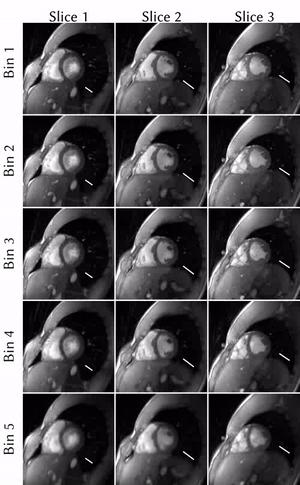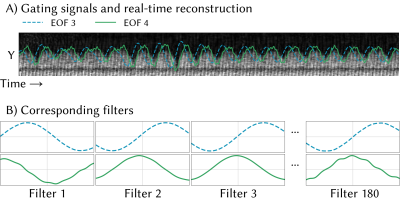Sebastian Rosenzweig1,2 and Martin Uecker1,2
1Diagnostic and Interventional Radiology, University Medical Center Göttingen, Göttingen, Germany, 2Partner Site Göttingen, German Centre for Cardiovascular Research (DZHK), Göttingen, Germany
1Diagnostic and Interventional Radiology, University Medical Center Göttingen, Göttingen, Germany, 2Partner Site Göttingen, German Centre for Cardiovascular Research (DZHK), Göttingen, Germany
We present novel insights on the quadrature-pair self-gating signals estimated by SSA-FARY: We show that one element of each pair is certain to be in-phase with the motion it represents, as it is the result of a filtering process with a zero-phase filter.

FIG_3 SSA-FARY-gated compressed sensing recontruction of the heart. All three SMS-slices are depicted. The respiratory motion is resolved into 5 bins using SSA-FARY amplitud-binning. The white lines serve as reference to appreciate the different respiratory states. Bin 1: End-expiration, Bin 5: End-inspiration. The slightly blurred appearance of the fifth bin is a result of the limited number of spokes which were aquired in the typically shorter end-inspiration state.

FIG_2 Respiratory gating with SSA-FARY. A) The background shows the diaphragm-motion extracted from a real-time reconstruction of the entire time-series. On top, EOF 3 and EOF 4, i.e. the third and fourth column of the SVD-Matrix $$$U$$$, are plotted. B) For each EOF, four representative filters extracted from the$$$V^H$$$-matrix are depicted. Note, that the symmetric filters (green) correspond to EOF 4, which is in-phase with the diaphragm and which can therefore be used for amplitude-binning.
